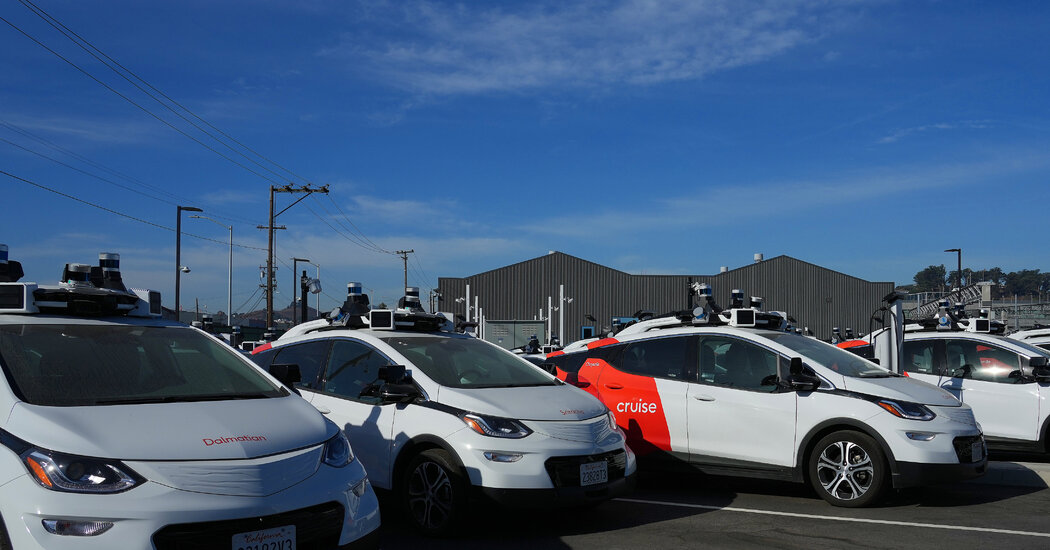
 Technology
Technology 
General Motors is slowing the expansion of its Cruise automated driving division and significantly cutting spending at the unit after suspending operations in response to growing safety concerns about its driverless cars.
The company had been planning to roll out a ride service in San Francisco and three other cities and begin testing Cruise vehicles on the streets of several other markets. It now plans to focus on only one city as it works to improve the operation of its fleet of driverless vehicles it has been testing.
“We expect the pace of Cruise’s expansion to be more deliberate when operations resume, resulting in substantially lower spending in 2024 than in 2023,” G.M.’s chief executive, Mary T. Barra, said Wednesday at an investor conference. “We must rebuild trust with regulators at the local, state and federal levels, as well as with the first responders and the communities in which Cruise will operate.”
Last month, California regulators suspended Cruise’s license to operate in the state after a Cruise self-driving vehicle in San Francisco ran over a pedestrian who had been hit by another car and dragged her for 20 feet.
The company responded by pulling all its driverless vehicles off the roads, citing a need to regain public trust.
G.M.’s chief financial officer, Paul Jacobson, said spending at Cruise would fall by “hundreds of millions of dollars” in 2024, and would probably fall further as the company reviewed the division’s operations.
Ms. Barra did not say how the drop in spending would affect Cruise’s work force, noting the company would provide more details after it reviewed independent safety reports on the San Francisco incident.
While commenting on Cruise, G.M. also gave a general business update, saying it expected to report 2023 net income of $9.1 billion to $9.7 billion — a slightly lower range than earlier forecasts — after strikes halted operations at three of its plants in the fall.
G.M. said the walkouts had cost the company $1.1 billion in operating profit and lowered its production by about 95,000 vehicles. It also said the new labor agreements with the United Automobile Workers union and Canada’s Unifor union — both of which include substantial wage increases — would add $500 to the cost of its North American vehicles in 2024. Ms. Barra said the increase in labor costs, however, would be “fully offset” by cost-cutting measures the company had been carrying out over the last year or so.
G.M. also said it would buy back up to $10 billion of its stock in a bid to raise the share price. “Our stock price is disappointing to everyone,” Ms. Barra said. After G.M.’s announcement, its shares rose 11 percent in early trading; they ended the day up 9 percent at nearly $32, though still barely half their price two years ago.
She also said G.M. expected to increase production of electric vehicles significantly in 2024, after encountering lower-than-expected demand and delays in ramping up its E.V. output this year.
“Although the rate of growth is lower, E.V. demand is clearly moving in the right direction,” she said. “There’s really no reason E.V. demand won’t be higher in the years ahead.”
In her address, Ms. Barra said G.M. remained optimistic about Cruise’s future. “What Cruise has accomplished in the eight years since we acquired the company is remarkable,” she said. “Our priority now is to focus the team on safety, transparency and accountability.”
Founded in 2013 and bought by G.M. in 2016, Cruise is one of several startups that have been working to develop self-driving cars with the goal of creating a driverless-taxi business in cities across the United States. One of its rivals is Waymo, which is owned by Alphabet, the parent of Google.
Cruise has been testing self-driving taxi services in San Francisco, Phoenix, Houston and Austin, Texas, and it has tested its autonomous vehicles in six other cities, including Nashville and Seattle. In August, California regulators approved a move to let Cruise and Waymo charge for their driverless services around the clock in San Francisco, after having operated on a limited scale for over a year.
But in San Francisco, city officials, firefighters and police officers said Cruise’s driverless cars were posing safety risks and causing congestion by blocking fire trucks, stopping in the middle of busy streets and delaying firefighters’ responses to save lives.
Early this month, Cruise suspended an employee share buyback program after saying its valuation had changed. The suspension of the buyback program was earlier reported by Reuters.
On Nov. 19, Kyle Vogt, Cruise’s chief executive and a founder of the company, resigned. Dan Kan, the chief product officer, resigned later. Cruise did not appoint a replacement for Mr. Vogt.
In an email to Cruise employees at the time, Ms. Barra said she and the rest of Cruise’s board were “focused on setting Cruise up for long-term success,” adding: “Public trust is essential to this. As we work to rebuild that trust, safety, transparency and accountability will be our North Stars.”
24World Media does not take any responsibility of the information you see on this page. The content this page contains is from independent third-party content provider. If you have any concerns regarding the content, please free to write us here: contact@24worldmedia.com